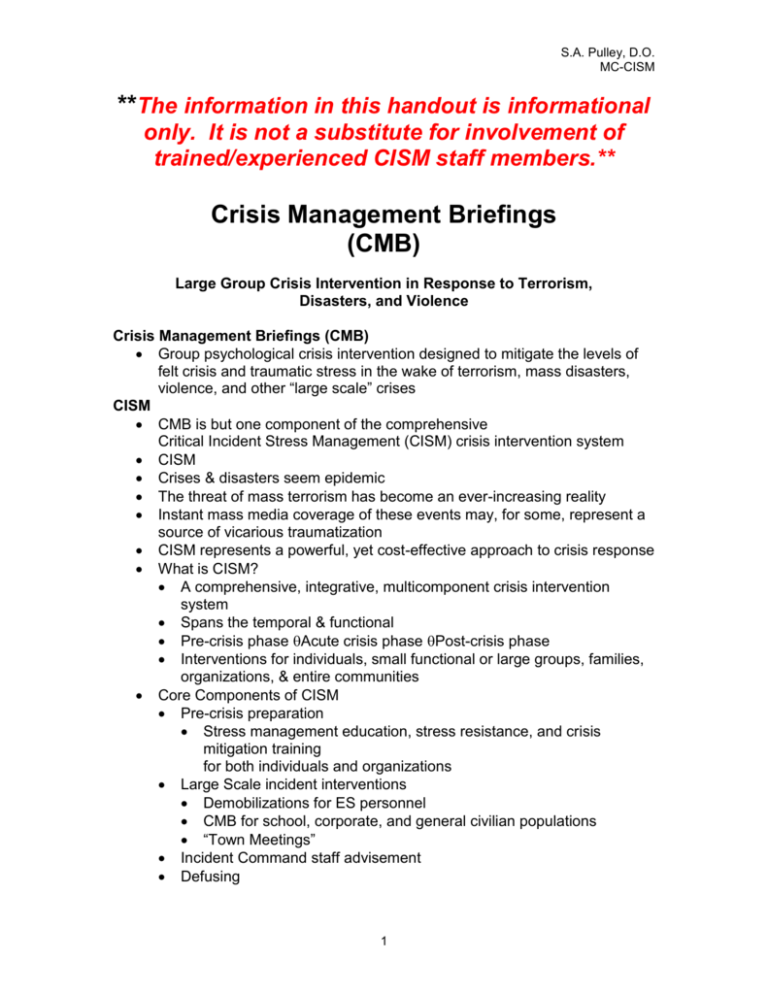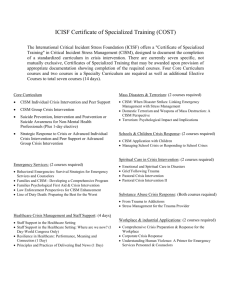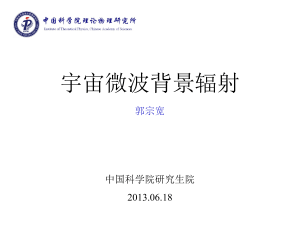Crisis Management Briefing
advertisement

S.A. Pulley, D.O. MC-CISM **The information in this handout is informational only. It is not a substitute for involvement of trained/experienced CISM staff members.** Crisis Management Briefings (CMB) Large Group Crisis Intervention in Response to Terrorism, Disasters, and Violence Crisis Management Briefings (CMB) Group psychological crisis intervention designed to mitigate the levels of felt crisis and traumatic stress in the wake of terrorism, mass disasters, violence, and other “large scale” crises CISM CMB is but one component of the comprehensive Critical Incident Stress Management (CISM) crisis intervention system CISM Crises & disasters seem epidemic The threat of mass terrorism has become an ever-increasing reality Instant mass media coverage of these events may, for some, represent a source of vicarious traumatization CISM represents a powerful, yet cost-effective approach to crisis response What is CISM? A comprehensive, integrative, multicomponent crisis intervention system Spans the temporal & functional Pre-crisis phase Acute crisis phase Post-crisis phase Interventions for individuals, small functional or large groups, families, organizations, & entire communities Core Components of CISM Pre-crisis preparation Stress management education, stress resistance, and crisis mitigation training for both individuals and organizations Large Scale incident interventions Demobilizations for ES personnel CMB for school, corporate, and general civilian populations “Town Meetings” Incident Command staff advisement Defusing 1 S.A. Pulley, D.O. MC-CISM 3-phase, structured small group discussion provided within hours of a crisis Assessment, triaging, & acute symptom mitigation Critical Incident Stress Debriefing (CISD) 7-Phase “ICISF model” 1-10 days post crisis (3-4 weeks in disaster) Mitigates acute symptoms, assess the need for follow-up, and if possible provide a sense of post-crisis psychological closure One-on-one crisis intervention/ counseling or psychological support throughout the full range of the crisis Family crisis intervention and Organizational consultation Follow-up and Referral mechanisms for assessment and treatment, if necessary CRISIS MANAGEMENT BRIEFINGS (CMB) A Four Phase group crisis intervention Requires from 45 to 75 minutes It may be used with “large” groups consisting of 10 to 300 individuals Designed to be used with primary victim civilian populations in the wake of terrorism, mass disasters, violence, and other large-scale crises Crisis Management Briefing May be implemented in: Schools Corporations Community settings It may have applicability in other settings with other populations It is but one component within the comprehensive CISM system The CMB is designed to be used within a comprehensive CISM framework It should not be used as a “stand-alone” intervention PHASE ONE The first phase consists of bringing together a group of individuals who have experienced a common crisis event In response to a school crisis, for example, an assembly could be held in the auditorium Depending upon the number of students, one grade could be addressed at a time Or other divisions of the student body could be used In response to a workplace crisis, a company meeting room could be used Or a room could be rented at a local hotel or commercial meeting facility In response to mass disasters, large-scale violence, or terrorism Local school auditoriums could be used to address the civilian populations They could correspond to the respective school or voting districts Announcements could be made via radio, television, and internet sites 2 S.A. Pulley, D.O. MC-CISM Repeat the CMB until all constituents have been addressed within the given circumscribed area/population This act of assembly is the first step in reestablishing the sense of community that is so imperative to the recovery and rebuilding process PHASE TWO Have the most appropriate and credible sources or authorities explain the facts of the crisis event Respected & highly credible spokesperson Develops the perceived credibility of the message and the belief that the actions and support will be effective The ethos of the spokesperson contributes to the effectiveness of the message/information being disseminated Objective and credible information should serve to: Control destructive rumors Reduce anticipatory anxiety Return a sense of control to victims Maintain confidentiality Receive factual information concerning that which is, and is not, known PHASE THREE Discuss the most common reactions that are relevant to the crisis event Signs Symptoms Psychological themes For example: In suicide, the psychological theme of suicide should be addressed In terrorism, the dynamics of terrorism should be discussed Common signs and symptoms of Grief Anger Stress Survivor guilt Responsibility guilt And how they relate to survivors, friends, and others PHASE FOUR Address personal coping and self-care strategies that may be of value in mitigating the distressing reactions Simple, practical, stress management strategies should be discussed Community & organizational resources available to facilitate recovery Questions should be actively entertained as appropriate Each group participant given a reference sheet that briefly describes: Common signs and symptoms Common stress management techniques 3 S.A. Pulley, D.O. MC-CISM Timing Local professional resources (with contact information) available to aid recovery Timing for the CMB is highly situation-specific and flexible The CMB can be repeated as long as it proves to be useful Summary CMB is as an efficient large group crisis intervention that may be used for primary civilian populations (and perhaps others) CMB is useful in the wake of terrorism, mass disasters, violence, and similar large-scale community-wide or school organizational crises CMB provides a standardization of large group crisis intervention procedures Standardization provides reliability in application/implementation The human resource is the most valuable resource any organization or community possesses CMB is designed to protect that human resource Reference Everly GS. Crisis Management Briefings (CMB): Large Group Crisis Intervention in Response to Terrorism, Disasters, and Violence. [International Journal of Emergency Mental Health, 2000, 2(1), 53-57 Located at www.icisf.org under articles 4










